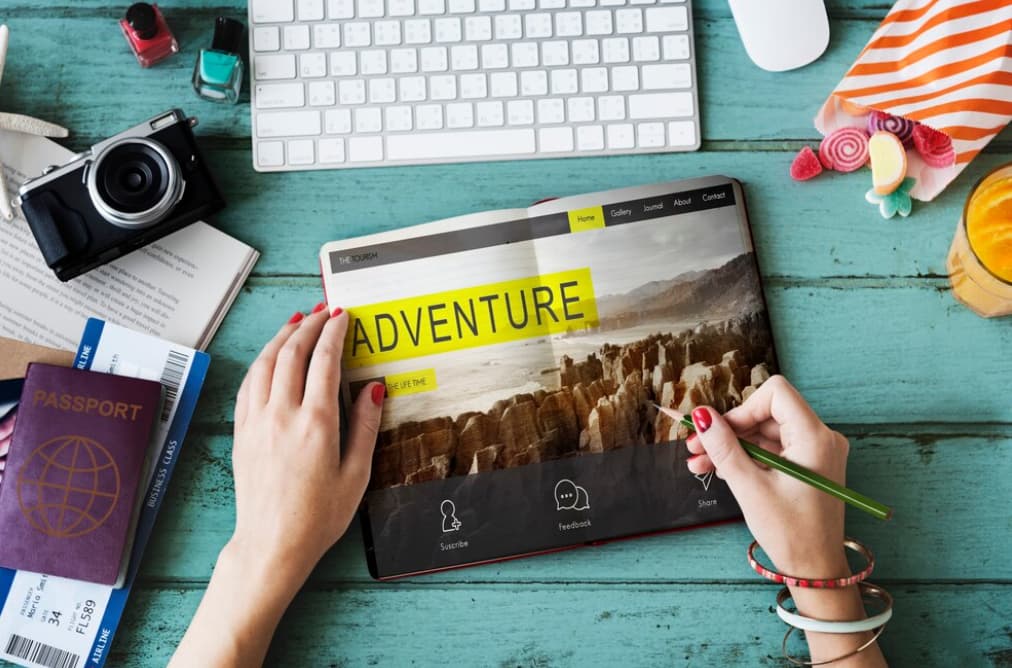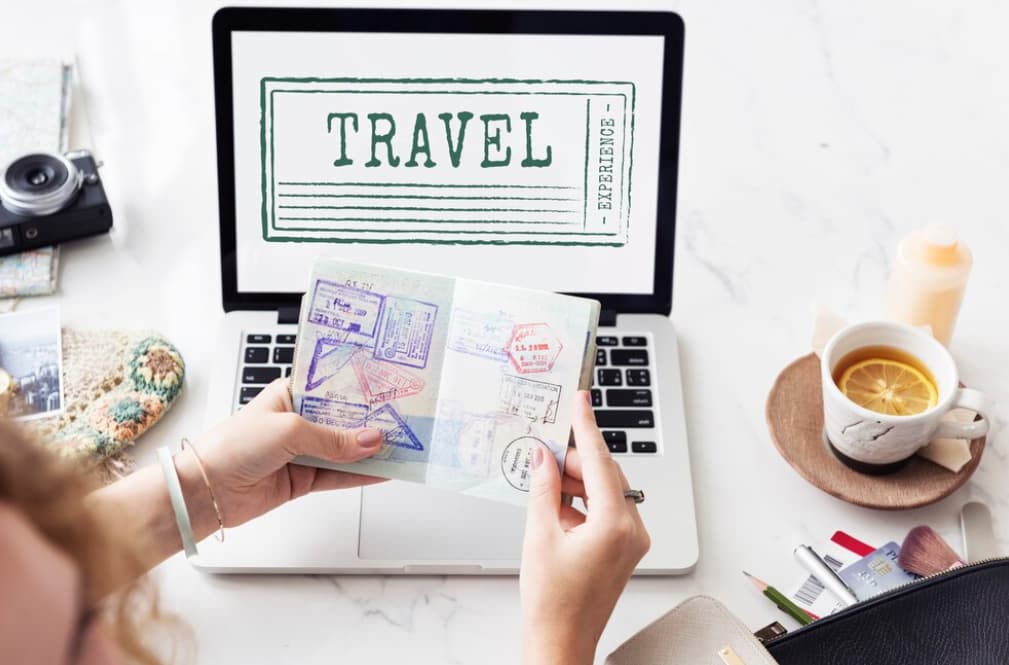The travel industry is experiencing significant growth, with 80% of travelers organizing their trips via the Internet. This presents an ideal opportunity to initiate a travel blog. Many travel bloggers manage to earn a part or full-time income from their blogging activities. The forthcoming article will detail the process of turning into a professional travel blogger.
Embarking on a blogging journey is not without its challenges. Managing a personal blog as well as client blogs for over five years has provided extensive experience in the field. However, having the correct guidance can simplify the process.
The article will outline essential steps to create a travel blog, offer advice for achieving success as a blogger, and provide answers to frequently asked questions. Additionally, for those embarking on the journey of starting a travel blog successfully, you may also like to explore effective strategies for crafting engaging website homepage content.
Creating a Travel Blog
For aspiring bloggers, the journey involves branding, setting up a blog, and expanding the reader base. Follow these steps for success:
- Select a niche;
- Develop your brand;
- Choose a blogging platform;
- Customize your blog’s design;
- Understand SEO principles;
- Publish your initial post;
- Increase your readership.
Step 1: Choose a niche
Embarking on the journey to become a travel blogger means stepping into a vast field. To effectively connect with a specific audience, it’s crucial to refine your broad niche into a more focused area.
A general niche faces stiff competition due to the sheer number of travel bloggers out there. By specializing, you distinguish yourself. For instance, while the travel blogging sphere is crowded, there are fewer bloggers focusing on budget travel, presenting an opportunity to stand out.
Consider these examples of specialized travel niches:
- Backpacking adventures;
- Solo journey experiences;
- Theme park vacations, such as Disney;
- Travel focused on specific locations;
- Opulent luxury getaways;
- Family-oriented travel experiences.
Choosing a specialized niche not only reduces competition but also allows for a deeper connection with a dedicated segment of the travel audience.
Step 2: Develop your brand
Securing a niche paves the way for brand development, a crucial step for audience growth and trust building. A distinct brand identity makes it easier for potential followers to recognize and remember your blog.
Key elements to consider when forming your brand include:
- The name of your blog, ensuring it’s not already trademarked;
- A unique logo;
- A color scheme that reflects your blog’s tone and theme;
- Typography that enhances readability and appeal;
- Understanding your target audience, including their demographics and specific needs;
- Setting clear objectives for what you wish to achieve with your travel blog.
Maintaining consistency across various platforms, such as social media or YouTube, is essential for brand cohesion.
For those looking to professionalize their brand image further, engaging a designer can be beneficial. Platforms like Upwork offer access to freelance designers who specialize in brand creation, providing an affordable solution for those just starting out.
Step 3: Choose a blogging platform
The choice of a blogging platform is pivotal, with numerous options available such as Squarespace, WordPress, Wix, and others. Each platform offers unique features and benefits tailored to different blogging needs.
Squarespace is a favored choice among bloggers for several reasons:
- Cost-effectiveness, making it accessible for bloggers at various levels;
- Comprehensive features that bundle hosting, SEO tools, and eCommerce capabilities, streamlining the blogging experience;
- A wide array of customizable templates, enabling bloggers to create a distinct look for their blog;
- User-friendly interface that simplifies blog setup and customization;
- Advanced analytics features, providing insights into blog performance and audience behavior.
When selecting a platform, consider factors such as ease of use, customization options, scalability, and the specific tools each platform provides to support your blogging goals.
Step 4: Customize your blog’s design
After creating an account on your chosen blogging platform, it’s time to tailor the design to fit your travel blog’s theme. The process varies depending on the platform you’ve selected.
For instance, if you’re using WordPress, customization may involve coding or integrating plug-ins. On the other hand, platforms like Squarespace and Wix provide pre-designed templates that you can easily modify to suit your preferences.
Ensure to infuse your branding elements such as logos, fonts, and color schemes into the design to maintain consistency with your overall brand identity.

Step 5: Understand SEO principles
Prior to embarking on your inaugural travel blog post, familiarizing yourself with search engine optimization (SEO) is crucial. SEO serves as the gateway through which your intended audience discovers your blog amidst the vast online landscape.
There exists an array of SEO techniques at your disposal, among which keyword research and utilization stand out as paramount. By strategically incorporating relevant keywords, you can effectively convey the essence of your content to search engines like Google, facilitating its visibility to the desired audience.
It’s perfectly acceptable to commence your journey by acquainting yourself with the fundamentals of SEO, progressively delving deeper into its intricacies over time. Nonetheless, the more adept you become at comprehending and integrating SEO principles, the greater the likelihood of your blog’s success in capturing and retaining the attention of your target readership.
Step 6: Publish your initial post
Now that you’ve grasped the essentials of becoming a travel blogger, it’s time to embark on crafting your inaugural article.
Follow these straightforward steps to compose a blog post that resonates with both your audience and Google:
| Step | Description |
|---|---|
| Conduct keyword research | Utilize Keysearch tool. Enjoy a 20% discount with code KDISC. |
| Develop an outline | Leverage Keysearch’s content assistant feature. Gather insights from the top three-ranking pages on Google for chosen keyword. Craft structured outline. |
| Craft your content | Integrate real-life anecdotes, statistical data, personal experiences, and practical solutions. |
| Edit and proofread | Refine content using Grammarly for clarity and coherence. Conduct thorough proofreading session aloud. |
| Incorporate images | Access free stock photos from Unsplash or use captivating travel imagery. |
| Request indexing via Google Search Console | Notify Google of freshly published content for prompt inclusion on SERPs. |
Step 7: Increase your readership
Following the publication of your inaugural article, the key to achieving success lies in continuously expanding your audience base. With a growing readership, your blog has the potential to generate income over time.
Here are actionable strategies to enhance your blog’s visibility and increase traffic:
- Maintain a consistent flow of SEO-optimized blog articles;
- Utilize Canva to design a valuable freebie, such as a packing checklist, to entice and engage your audience;
- Launch an email newsletter using Flodesk, encouraging readers to subscribe by offering your freebie as an incentive;
- Leverage Canva to craft visually appealing graphics tailored for Pinterest, a platform renowned for driving significant traffic to blogs;
- Extend your reach by sharing relevant content across social media channels such as Instagram and TikTok, fostering connections with a broader audience base.
Crafting Compelling Content for Your Travel Blog
When it comes to writing for your travel blog, it’s essential to address subjects that resonate with your niche audience and address their queries effectively.
For instance, if your blog focuses on solo travel, consider creating content centered around solo travel tips, the advantages of embarking on solo adventures, and top destinations ideal for solo travelers. These thematic clusters are commonly referred to as content pillars.
Pro Tip: Utilize Answerthepublic.com to discover an array of topic ideas pertinent to your niche and audience interests.
Essential Travel Blogging Tips
Discover below a curated selection of essential travel blogging tips to enhance your blogging prowess.
Stand Out in the Travel Blogging Crowd
In a vast landscape of travel blogs online, standing out is essential. Here are practical ways to differentiate yourself and build a loyal audience as a travel blogger:
- Find Your Niche: Focus on a specific area of travel that you know well;
- Share Personal Experiences: Offer insights and anecdotes that are unique to your adventures;
- Be Relatable: Connect with your audience by showing your personality and being down-to-earth;
- Engage Your Readers: Encourage interaction and feedback to make your audience feel valued and understood.

Contributing Guest Articles to Travel Blogs
Contributing guest articles to various travel blogs is an effective strategy for enhancing visibility and expanding audience reach. Websites frequently welcome submissions from bloggers, offering credit through backlinks to the contributor’s blog. These backlinks are instrumental in improving a website’s SEO. To propose article ideas, one should seek out prominent travel blogs that have a dedicated “write for us” section, outlining their submission guidelines. Opting against cold-pitching and instead focusing on platforms that explicitly invite contributions can lead to more efficient use of efforts in securing publishing opportunities.
Achieving Success Through Consistent Blogging
Achieving success as a blogger hinges on one crucial factor: consistency. It’s not enough to sporadically post articles and hope for sustained success. While initially, your existing content might continue to attract attention, Google’s algorithms are unforgiving to stagnant blogs, eventually rendering them outdated.
The frequency of publishing new content remains a subject of perpetual debate. Some opt for daily updates, while others prefer a more manageable weekly schedule. Undoubtedly, the quality of your posts matters greatly; however, quantity also plays a significant role.
Take, for example, the case of Amy Fillinger, a seasoned travel blogger. In June 2022, after four years of consistent effort, she published nine articles and reaped the rewards, earning $4,223.94 through advertisements and affiliate partnerships.
Consistency is the key. Establishing a feasible publishing schedule for the upcoming months and adhering to it diligently is paramount. Consider committing to a single weekly post initially, then assess and adjust your strategy accordingly.
Continuous Learning
Achieving success in blogging requires a commitment to continuous learning. The field is vast and constantly evolving, with new trends and techniques emerging regularly. To stay ahead, bloggers must be proactive in staying informed and adapting to changes.
Seek Assistance
Once your blog begins generating revenue, consider enlisting assistance to enhance publication frequency and increase earnings further. With a solid base of traffic and revenue streams already established, bringing on additional support can yield a positive return on investment, alongside augmented income.
Having collaborated with numerous bloggers, assistance has been provided to lighten their workload by contributing to the creation of several blog posts each month. This strategy enables them to achieve their income targets through their blogs.
Consider also the option of hiring a social media manager or an email copywriter to bolster your blog’s marketing efforts.
Frequently Asked Questions
Embarking on a travel blogging journey is a fantastic venture, as there’s a high demand for travel insights online. With various monetization strategies available, such as affiliate marketing, advertising revenue, and the sale of digital products, one can reach a wide audience and generate income.
Kick off your travel blogging adventure with this SEO blogging toolkit for smoother navigation.
Income for travel bloggers varies widely, from nothing to substantial five-figure sums monthly, influenced by content quality, audience reach, and diversified revenue streams. For instance, World Family Travel reported an average monthly income of around $1,600 in 2021, whereas Travel Blog Viewpoint disclosed earnings of $24,758 in May 2022.
The journey to becoming a successful travel blogger demands dedication, time, and effort. Building a personal brand, mastering SEO, and crafting content are key steps. Initially, the commitment might require over 10 hours weekly, but this can decrease significantly once a solid base is established.
Challenges in travel blogging include the initial time commitment, stiff competition, and the complexities of managing a blog while traveling full-time.
Before launching a travel blog, it’s crucial to reflect on your objectives and consider both the advantages and challenges. Regularly review your progress to ensure you are on the path to achieving the benefits of blogging.
Conclusion
Inaugurating a blog demands considerable effort yet offers a fulfilling and potentially lucrative avenue to forge multiple income channels. This guide aims to empower you with the knowledge and confidence needed to embark on your journey as a travel blogger.
